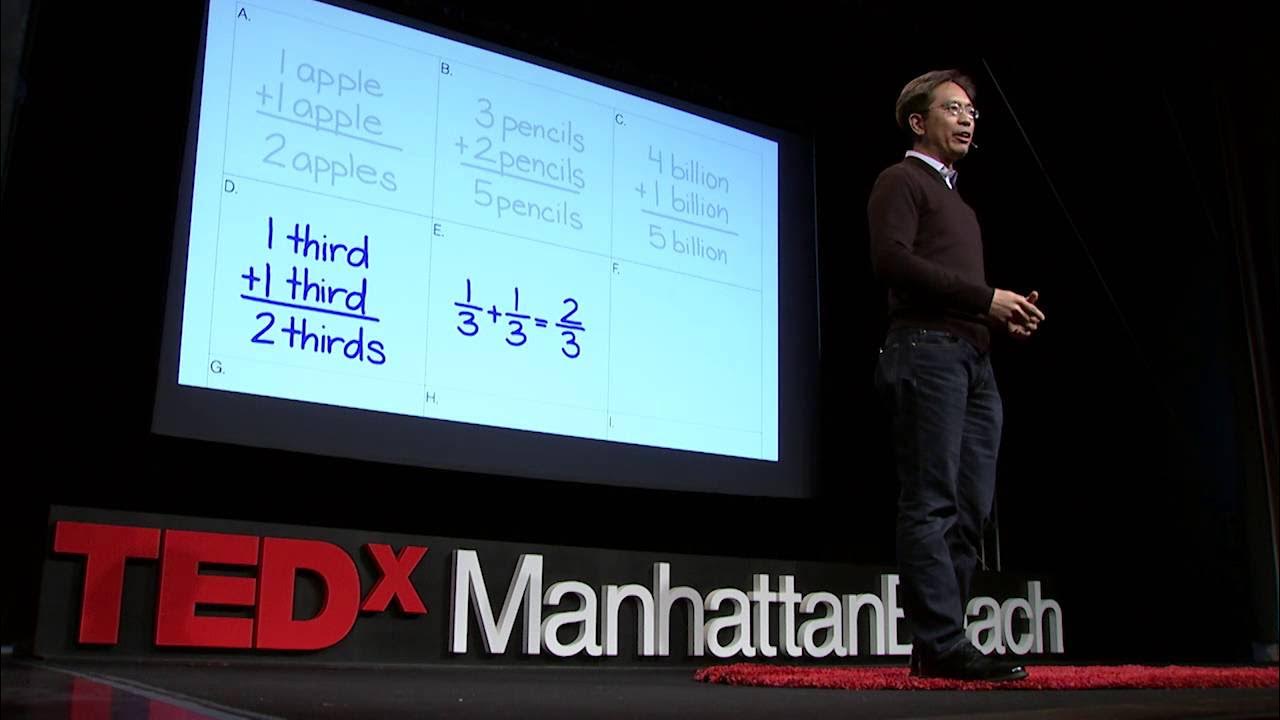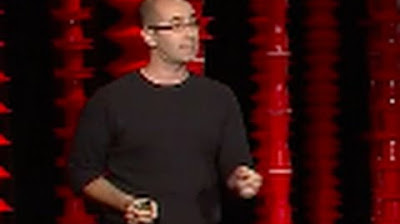Mathematics is the sense you never knew you had | Eddie Woo | TEDxSydney
TLDRThe speaker, once an outsider to mathematics, shares a personal journey of discovery and transformation into a math educator. Initially struggling with the subject and perceiving it as a dry, formulaic discipline, the speaker's perspective shifts after an encounter at Sydney University. Recognizing a shortage of math teachers, the speaker is encouraged to pivot to teaching mathematics. Through this transition, they come to appreciate the beauty and practicality of math, realizing it's about asking the right questions and seeing problems in new ways. The talk delves into the concept of 'fractals', illustrating how mathematical patterns are ubiquitous in nature, from river deltas to blood vessels. The speaker argues that math is a sense that can be honed, just like sight or hearing, and that recognizing patterns is a fundamental human trait. They highlight the role of patterns in art and nature, including the significance of the 'golden ratio' in design and the spiral patterns in sunflowers. The narrative concludes with a celebration of math as an integral part of the human experience and the cosmos, encouraging a broader appreciation for the subject.
Takeaways
- 🎓 **Personal Struggle with Maths**: The speaker shared their initial struggle with mathematics, highlighting a common feeling among many that maths can be daunting and isolating.
- 🏫 **Status and Maths in School**: The importance of mathematics in the speaker's high school, where social status was tied to one's maths class ranking, emphasizing societal pressures and the perceived value of the subject.
- 👓 **Misconceptions about Maths**: The speaker dispelled stereotypes about who can be good at maths, challenging assumptions based on race and appearance.
- 📚 **Unexpected Career Path**: The journey from English and history enthusiast to maths teacher, influenced by a conversation and the need for maths educators, illustrating the impact of chance encounters and societal needs.
- 🤔 **Rethinking Maths**: The realization that mathematics is more than just formulas and calculations; it's about problem-solving, creativity, and asking the right questions.
- 🎼 **Parallel with Music**: Drawing a comparison between the speaker's experiences with learning piano and later guitar, to convey how a shift in perspective can transform one's relationship with a subject.
- 👀 **Maths as a Sense**: The idea that mathematics is a sense that allows us to perceive realities and patterns, much like sight or touch, offering a new way to understand and appreciate the world.
- 🌿 **Fractals in Nature**: The concept of fractals and their prevalence in natural phenomena, from river deltas to trees and lightning, showing the interconnectedness of mathematical patterns in the world around us.
- 🌸 **Mathematics and Beauty**: The aesthetic appeal of mathematical patterns, as seen in Islamic art, flower symmetry, and the golden ratio, underlining the harmony between maths and beauty.
- 🧠 **Human Pattern Recognition**: The innate human ability to recognize and create patterns, which is a fundamental aspect of various art forms and is also at the core of mathematical thinking.
- 🤓 **Embracing Maths**: The speaker's final message encouraging pride and enthusiasm for mathematics, regardless of social settings, as it is an integral part of human experience and the universe's structure.
Q & A
Why did the speaker initially feel like an outsider in the field of mathematics?
-The speaker felt like an outsider because they struggled with mathematics and their high school highly valued it, which caused angst for the speaker who excelled in English and history instead.
What was the societal perception of mathematics in the speaker's high school?
-In the speaker's high school, the status of a student was closely tied to their ranking in mathematics classes, with being in a higher class indicating a higher status, similar to royalty.
How did the speaker's perspective on mathematics change after the encounter at Sydney University?
-The speaker's perspective changed when a professor at Sydney University recognized their perseverance in mathematics and encouraged them to become a mathematics teacher due to a shortage of math educators in Australian schools.
What was the speaker's initial career goal before deciding to teach mathematics?
-The speaker initially aimed to become an English and history teacher because they felt at home with stories, characters, and narratives.
How did the speaker's view of music relate to their view of mathematics before their perspective changed?
-The speaker initially viewed both music and mathematics as dry, solitary, and joyless exercises that they engaged in only because they were forced to, not because of any personal interest or enjoyment.
What is the significance of the river delta and tree shapes in the context of the speaker's discussion about mathematics?
-The river delta and tree shapes are significant because they are examples of fractals, which are mathematical shapes found in nature. The speaker uses these examples to illustrate the inherent mathematical patterns in the natural world.
What is a fractal, according to the speaker?
-A fractal is a mathematical shape that is found in nature, characterized by a broken and shattered appearance. Fractals are self-similar patterns that can be found at different scales, from the smallest to the largest parts of a whole.
How does the speaker describe the mathematical sense in relation to other human senses?
-The speaker describes the mathematical sense as a way to perceive realities that would otherwise be intangible, similar to how sight and touch allow us to perceive the physical world. It is a sense for patterns, relationships, and logical connections.
Why does the speaker believe that everyone is born to be mathematicians?
-The speaker believes that everyone is born to be mathematicians because all humans are wired to see and create patterns, which is the essence of mathematics. This innate ability to recognize and work with patterns is a fundamental aspect of mathematical thinking.
What is the 'golden ratio' and how does it relate to the patterns found in nature and human-made structures?
-The 'golden ratio' is a mathematical reality that appears in various natural and human-made structures. It is a special number that, when used to create spirals, results in aesthetically pleasing and efficient patterns, such as those found in sunflowers and various architectural designs.
How does the speaker's personal experience with vision impairment relate to the common perception of struggling with mathematics?
-The speaker uses their personal experience with vision impairment to draw a parallel with the common perception that some people have about struggling with mathematics. Just as they would not dismiss their ability to see entirely, people should not dismiss their ability to engage with and appreciate mathematics.
What is the speaker's ultimate message about the relationship between humans and mathematics?
-The speaker's ultimate message is that mathematics is an inherent part of the human experience and the natural world. By recognizing and embracing our innate mathematical sense, we can better appreciate the patterns and structures that make up our universe.
Outlines
🎓 From Outsider to Maths Enthusiast
The speaker, Eddie, humorously admits that professing a love for mathematics at a party might not make one the life of the event. He identifies as an 'outsider' to the subject, having struggled with it and ranking low in his school's maths hierarchy. Despite the societal and school pressures that favor maths, Eddie's initial interests lay in English and history. However, a conversation with a university professor led to a career change into teaching mathematics due to a shortage of maths educators in Australia. As Eddie pursued his degree, he discovered that maths was not the dry subject he had once believed it to be, but rather a field that required creativity and problem-solving, much like music, which he later came to appreciate.
🌐 The Practical Beauty of Mathematics
Eddie shares his transformation from viewing mathematics as a dry subject of rote memorization to recognizing its practicality and beauty. He explains that maths is about asking the right questions and creatively solving problems, not just finding answers. He introduces the concept of mathematics as a 'sense' that allows us to perceive realities that would otherwise be intangible. Using the example of a river delta, Eddie illustrates the geometric patterns found in nature, which are mathematically described as 'fractals'. He points out that these fractal patterns are not only seen in natural phenomena like rivers and trees but also in fleeting events like lightning and within our own bodies, in the form of blood vessels. Fractals are a testament to the mathematical reality that underlies the universe, a reality that we can learn to perceive with practice.
🎨 The Artistry in Mathematical Patterns
Eddie emphasizes the connection between mathematics and the arts, noting that those who excel in creating patterns are often referred to as artists. He highlights the intricate mathematical patterns found in Islamic art and the beauty of symmetry in flowers, which grow in spirals. The angle of these spirals, he explains, can greatly affect the efficiency and beauty of the flower, with the sunflower's spiral being particularly noteworthy as it relates to the 'golden ratio'. This ratio is a mathematical constant found universally, from the structure of our fingers to the design of ancient architecture. Eddie concludes by asserting the importance of recognizing and embracing the mathematical patterns that permeate our universe, as they are an integral part of human experience and the cosmos itself.
Mindmap
Keywords
💡Mathematics
💡Fractals
💡Patterns
💡Golden Ratio
💡Humanities
💡Mathematical Sense
💡Education
💡Aesthetics
💡Insight and Imagination
💡Cosmos
💡Selective School
Highlights
The speaker humorously admits that saying 'I love mathematics' at a party may not make you the life of the party.
The speaker identifies as an outsider to mathematics, despite being a math teacher, challenging stereotypes.
A chance encounter in university led to a career change from humanities to mathematics education due to a shortage of math teachers.
The speaker emphasizes the personal impact on students as the driving force behind becoming a teacher, regardless of the subject.
Mathematics is revealed to be a very different and more engaging subject than the speaker had previously thought.
The speaker draws a parallel between their experiences with learning music and mathematics, highlighting perseverance and a later discovery of joy in both.
Mathematics is described as immensely practical, beautiful, and about asking the right questions, not just finding answers.
The concept of mathematics as a 'sense' for perceiving realities and patterns is introduced.
Fractals are introduced as a mathematical reality found in nature, such as in river deltas, trees, and lightning bolts.
The importance of pattern recognition in human experience and the universe is discussed.
The speaker argues against the notion that some people are not 'mathematical' by nature, citing our innate ability to see and create patterns.
The beauty and symmetry in flowers, and the mathematical principles behind their growth patterns, are explored.
The golden ratio and its prevalence in nature and human design, from sunflower patterns to the Parthenon, are highlighted.
Islamic art and design are cited as striking examples of mathematical patterns in culture and aesthetics.
The speaker passionately declares a love for mathematics, encouraging others to embrace and explore its beauty and practicality.
Transcripts
Browse More Related Video

Math isn't hard, it's a language | Randy Palisoc | TEDxManhattanBeach

The magic of Fibonacci numbers | Arthur Benjamin | TED

The Mandelbrot Set: Atheists’ WORST Nightmare

Decoding the Secret Patterns of Nature - Fibonacci Ratio & Pi - Full Documentary

The HACK to ACE MATH no matter what - Caltech study tip

Why is algebra so hard? | Emmanuel Schanzer | TEDxBeaconStreet
5.0 / 5 (0 votes)
Thanks for rating: